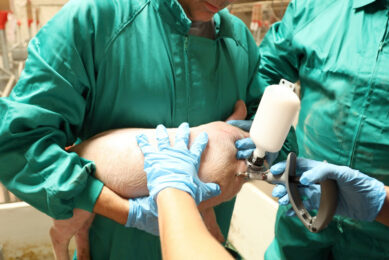Forward defences are key to pig profitability
![Control over the most frequently observed pathogenic micro-organisms will lead to better ROI and provides much better general performance in the farrowing house. [Photo: Jan Willem Schouten]](https://www.pigprogress.net/app/uploads/2021/04/002_130_rb-image-2697673-848x565.jpeg)
Properly applied biosecurity practices could have a significant impact on the profitability of a pig farm. Therefore excluding pathogens from entering a farm through disinfection ?procedures should take high priority.
Developed animal industries are characterised by on-site biosecurity programmes, which are designed to prevent or minimise incursions by known infectious diseases. These programmes are supported by close veterinary and laboratory surveillance for animal health. A newly emergent disease can therefore most likely be recognised quickly in any developed animal industry.
The costs of diseases within the US poultry industry for example clearly indicates how destructive pathogens can be for animal welfare and for the economic benefits which the animal farm industry is trying to accomplish.
In 1982, professor Peter M. Biggs of the Houghton Poultry Research Station reported that the total economic costs of disease (including vaccines and condemnations) were about 20% of the gross value of production (GVP) and about three times the cost of losses from mortality. An analogous 2007 analysis conducted by the University of Georgia, United States, calculated that the GVP of the United States poultry industry in 2005 was US$28.2 billion, and disease losses were 8.2% of this. Both studies showed that for each US$1,000 loss due to mortalities, another US$2,000 is lost elsewhere owing to depressed productivity resulting from disease.
Sustainable and profitable production
The most important measure for sustainable and profitable production on an animal site is to have forward defences in place – i.e., a biosecurity programme whose components work together to reduce the risk of the introduction of animal pathogens into a production site. For further and pathogen-specific protection measures, the farmer will also need to have correctly applied vaccination programmes for the dangerous animal pathogens that are known to be active in that region. Through this, disease outbreaks can largely be prevented, even if such pathogens gain entry to the site. A second tier of vaccinations – such as against some major immunosuppressive and respiratory disease agents (profit-erosive) – is also highly desirable.
For animal disease control, the most common problem on sites in many countries is their overreliance on vaccinations, rather than investing to achieve effective site biosecurity. The primary approach to animal health on a production site should be to attempt to exclude diseases, rather than allowing relatively ready entry of a pathogen to herds and then attempting to reduce its effects by immune protection, i.e., vaccination.
Five pillars of control
The five pillars described below represent the major technology-based approaches currently available for the control and prevention of infectious diseases of animals. While quarantine, hygiene and disinfection are universally applicable against animal pathogens, vaccination can be widely, but not always used and eradication is currently feasible only for a few pathogens.
Pillar 1 – Quarantine:
Currently, genetically based disease resistance is rarely of practical use in the field. This means that isolation is the only option. This is the oldest of the approaches, and dates back to Roman times, when a 40-day isolation period was enforced before the crew of a plague-stricken ship could enter a harbour or town. The Latin word for 40 is quadraginta, which has become quaranta in current-day Italian.
Pillar 2 – Hygiene and disinfection:
When animals/birds are being isolated from the entry of microbes, hygiene and cleaning are the first measures used. These must result in the removal of organic material from the surfaces to be decontaminated, for example, in animal houses if antimicrobial disinfection treatment is to be effective.
Pillar 3 – Vaccination:
This is probably the easiest and most economical group of methodologies to control and prevent diseases in animal production. However, it should not be used as the sole measure on a herd.
Pillar 4 – Eradication:
This is a feasible disease control option for only some specific animal pathogens. Relatively accurate and inexpensive lab tests have already been developed for detection of infection. Although a successful eradication programme requires major investments of resources, significant benefits can flow back to industry over the longer term.
Pillar 5 – Immunogenetic resistance:
Although immunogenetic resistance to disease is not yet complete, genetic selection could be applied to disease resistance, if commercial needs create pressure for this. At present, however, this is not seen as a high priority relative to other growth and production parameters. In addition, there is a lack of effective tools for selecting for specific resistance to many major infectious animal diseases.
Destroying antimicrobial agents
Given the details above, livestock producers have to put more emphasis on disinfectants which are antimicrobial agents designed to destroy micro-organisms. These substances are very important part of any hygiene and disinfection procedures. In this regard, Danish company Vitfoss offers Stalosan F – a powder disinfectant that provides sustained suppression of pathogens commonly observed in animal housing facilities worldwide.
Some of the recently conducted studies, see Tables 1-3, exhibit the potential of this product to supress some of the most highly pathogenic viruses currently existing and the presence of which lead to significant economic losses. Apart from control over the most frequently observed pathogenic micro-organisms, the disinfectant has proven to have a significant reduction of ammonia formation, absorb excessive moisture, decrease the pH-value of the litter, contribute to significantly better air quality through minimising the harmful emissions in the air and improve the overall performance of the herd. When applied weekly the product can improve the biosecurity status of the animals and minimise the disease spreading incidence.






